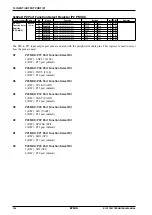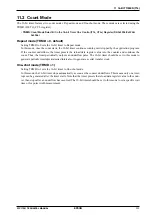
10 INPUT/OUTPUT PORT (P)
100
EPSON
S1C17001 TECHNICAL MANUAL
0x5208: P0 Port Chattering Filter Control Register (P0_CHAT)
Register name Address
Bit
Name
Function
Setting
Init. R/W
Remarks
P0 Port
Chattering
Filter Control
Register
(P0_CHAT)
0x5208
(8 bits)
D7
–
reserved
–
–
–
0 when being read.
D6–4
P0CF2[2:0]
P0[7:4] chattering filter time
P0CF2[2:0]
Filter time
0
R/W
0x7
0x6
0x5
0x4
0x3
0x2
0x1
0x0
16384/f
PCLK
8192/f
PCLK
4096/f
PCLK
2048/f
PCLK
1024/f
PCLK
512/f
PCLK
256/f
PCLK
None
0x0
R/W
D3
–
reserved
–
–
–
0 when being read.
D2–0
P0CF1[2:0]
P0[3:0] chattering filter time
P0CF1[2:0]
Filter time
0x0
R/W
0x7
0x6
0x5
0x4
0x3
0x2
0x1
0x0
16384/f
PCLK
8192/f
PCLK
4096/f
PCLK
2048/f
PCLK
1024/f
PCLK
512/f
PCLK
256/f
PCLK
None
D7 Reserved
D[6:4]
P0CF2[2:0]: P0[7:4] Chattering Filter Time Select Bits
Set the chattering filter circuit included in the P0[7:4] ports.
D3 Reserved
D[2:0]
P0CF1[2:0]: P0[3:0] Chattering Filter Time Select Bits
Set the chattering filter circuit included in the P0[3:0] ports.
The P0 port includes a chattering filter circuit for key entry, which you can select to use or not use (and
for which you can select a verification time if used) individually for the four P0[3:0] and P0[7:4] ports
using P0CF
x
[2:0].
Table 10.8.2: Chattering filter function settings
P0CF
x
[2:0]
Verification time
*
0x7
16384/f
PCLK
(8ms)
0x6
8192/f
PCLK
(4ms)
0x5
4096/f
PCLK
(2ms)
0x4
2048/f
PCLK
(1ms)
0x3
1024/f
PCLK
(512μs)
0x2
512/f
PCLK
(256μs)
0x1
256/f
PCLK
(128μs)
0x0
No verification time (Off)
(Default: 0x0,
*
when OSC3 = 2 MHz and PCLK = OSC3)
Note: • The chattering filter verification time refers to the maximum pulse width that can be
filtered. Generating an input interrupt requires a minimum input time of the verification
time and a maximum input time of twice the verification time.
• Input interrupts will not be accepted for a transition into SLEEP mode with the chatter-
ing filter left on. The chattering filter should be set off (no verification time) before ex-
ecuting the slp command.
• P0 port interrupts must be blocked when P0_CHAT register settings are being changed.
Changing the setting while interrupts are permitted may generate inadvertent P0 inter-
rupts.
• A phenomenon may occur in which the internal signal oscillates due to the time elapsed
until the signal reaches the threshold value if the input signal rise-up/drop-off time is
delayed. Since input interrupts will malfunction under these conditions, the input signal
rise-up/drop-off time should normally be set to 25 ns or less.
Summary of Contents for S1C17001
Page 1: ...Technical Manual S1C17001 CMOS 16 BIT SINGLE CHIP MICROCONTROLLER ...
Page 33: ...4 POWER SUPPLY VOLTAGE 24 EPSON S1C17001 TECHNICAL MANUAL This page intentionally left blank ...
Page 63: ...6 INITERRUPT CONTROLLER 54 EPSON S1C17001 TECHNICAL MANUAL This page intentionally left blank ...
Page 87: ...8 CLOCK GENERATOR CLG 78 EPSON S1C17001 TECHNICAL MANUAL This page intentionally left blank ...
Page 91: ...9 PRESCALER PSC 82 EPSON S1C17001 TECHNICAL MANUAL This page intentionally left blank ...
Page 133: ...11 16 BIT TIMER T16 124 EPSON S1C17001 TECHNICAL MANUAL This page intentionally left blank ...
Page 211: ...16 STOPWATCH TIMER SWT 202 EPSON S1C17001 TECHNICAL MANUAL This page intentionally left blank ...
Page 219: ...17 WATCHDOG TIMER WDT 210 EPSON S1C17001 TECHNICAL MANUAL This page intentionally left blank ...
Page 241: ...18 UART 232 EPSON S1C17001 TECHNICAL MANUAL This page intentionally left blank ...
Page 277: ...20 I2 C 268 EPSON S1C17001 TECHNICAL MANUAL This page intentionally left blank ...
Page 313: ...25 PACKAGE 304 EPSON S1C17001 TECHNICAL MANUAL This page intentionally left blank ...
















































